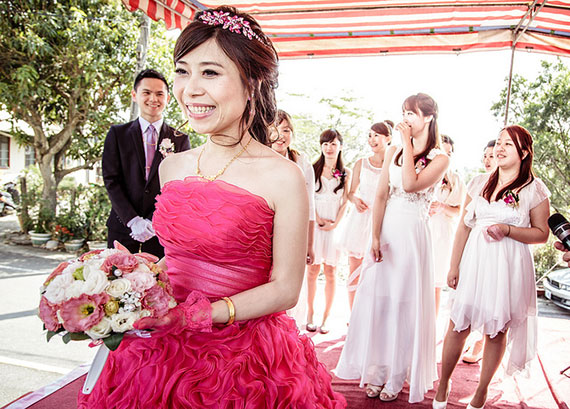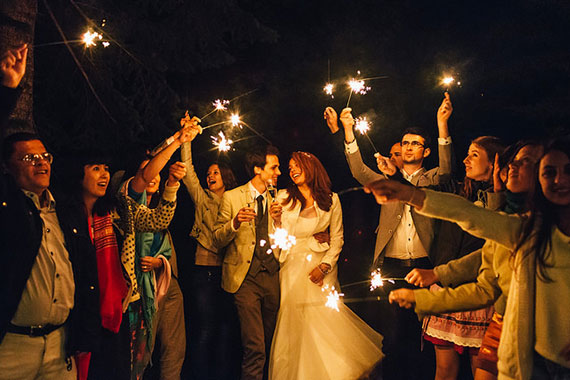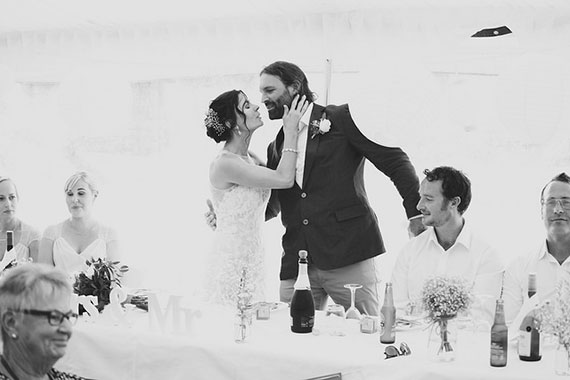As a Staffordshire based wedding photographer I look at a lot of wedding photography and it’s can be very hard to see something you love and not want to replicate the image in your next wedding. However, I don’t think that is the right way to approach shooting the day. Everyday is different and each couple has made their own choices, placed emphasis on particular parts of the day and designed their wedding in the way they want to celebrate it – this is the challenge and joy for me, creating a bespoke set of images that represents their day.

Photo by 古 天熱
If I went to shoot a wedding with a specific list of images in my mind I think I would fall into the trap of ‘imposing’ those shots upon the day, not seeing what is in front of me and trying to photograph that in the most compelling and interesting way. I’ve looked at the images of Yervant or Jerry Ghionis and there are some fantastic, breath-taking images but I’m also aware of the way they work and the sheer scale of intervention and the amount of time the Bride and Groom are away from their guests is not how I want to shoot a day. It suits some couples for sure (maybe they don’t like their families) but I’m trying to tell the human story of the day not give the couple a fashion shoot. But it is each to their own – each couple, each photographer has their own ideas and it’s about the two finding each other and knowing that the photographer’s style is the type of photography they want.
That is why I think it is paramount to shoot in a style that you are happy with, know works for you and above all gives you the images you were striving for. I have been asked in the past ‘Can you do ‘these’ particular shots?’ or ‘I’ve seen these photographs and would like everything like this on my day’. If it is a style far removed from the naturalistic images I make I have to say ‘That’s not what I do.’ If you just want the job you obviously say ‘Yes’, if you want to build a business with a ‘House Style’ and work that is obviously your own with a signature look people will seek out you have to say ‘No’.
When I compose a shot I try to include three elements within the frame that will create a story within the image. Context (where are we?), Narrative (What is the story we are telling here?) and Emotion (What is the feeling the image elicits?). Without all of these three elements I think that the image comes short of what is should be to tell a story.
Don’t get me wrong every photograph I see goes into the internal image bank and should feed my photography and hopefully I can draw from and develop great photography to suit the situation in front of me – rather than trying to bend the situation to suit someone else’s ideas or create images unsuitable for the day that is playing out in front of me.

Photo by Nuno Ferreira
In the first part I touched on what I think makes good wedding photography – how it should be a personal choice, a story that YOU want to tell, an aesthetic that is your vision – and in saying this it simply means that I can’t hope to dictate or impose the sort of images that you should be shooting nor would I. So simply over the next few articles I’m going to talk about how I prepare for a wedding shoot, what I look for, how I conduct myself, how I choose to shoot and how I post-process the images afterwards. Take from it what you will but make it your own.
Pre-shooting Preparation:
There are three fronts on which I have to make sure I’m prepared. Firstly, equipment. I always have 2 camera bodies with me (and I’m often shooting on both) and if I’m away for a night doing two consecutive weddings I’ll have a third body locked in the boot of my car just in case. The night before a shoot I make sure that cameras are cleaned, lenses dust free, batteries charged, spare batteries charged, memory cards formatted, cameras are pre-set to the settings I anticipate I’ll be using so I only have to make minor adjustments straight out of the bag. Flashes are checked and re-chargable batteries topped up with spares ready to go.
My current equipment list is as follows but it’s only how I shoot and I am using Canon cameras for the simple reason that I learned on them and know them well (I don’t get into the Canon/Nikon/Sony debate):
- Canon 5D mk 2
- Canon 1D mk 4
- 28mm Prime (wide and great in low light) – hotel rooms and family houses
- 50mm Prime (classic documentary length) – Reception and congratulations
- 85mm Prime (great close portrait lens) – Ceremony in smaller rooms, portraits
- 135mm Prime (Superb fast telephoto) – Big churches, reception and speeches
- 16-35mm (ultra-wide and a bit funky) – Evening Dance
- Flashes, batteries, spare batteries, cleaning material, lens hoods for everything, memory cards, off-camera flash cable, business cards, water, snacks, breath mints.
Secondly, details about the day. I talk to my couples about the day the first time they make an inquiry – I want to know what their choices are and how they are tailoring the day to suit them. I then meet up with them at the venue about a month before to make sure I have the final timetable of how the day is to run and any last minute thoughts, ideas or special things that they might have decided (write EVERYTHING down, you won’t remember it the night before or on the day). Then armed with all this information I can tailor my photography to their day. The night before I make myself a crib sheet that I can slip into my pocket and refer to on the day (it has on it the timetable, anything special things of note and when they might occur, any special requests and on the reverse a list of all the formal shots requested).
Thirdly, and this is the most esoteric of everything I do, I prepare mentally for the day ahead. I rehearse the day in my mind – when and where are things happening, what space is available to me, what’s the journey between venues, how long am I physically shooting before a break, what shots do I want to achieve (now this might fly in the face of a documentary approach but I want to make sure I’ve ‘banked’ certain shots to create a framework for the story of the day and then I can hang the reactive and situation led shots on that). I get my head into a place that is calm, observant, reactive and hopefully tuned to the day ahead.

Photo by Ryan Polei; ISO 500, f/4.0, 1/250-second exposure.
Next time what happens when, after all this preparation, I step into a room full of people getting ready and try to put everything into practice.
About the author:
Andrew Billington is a professional wedding photographer based in Staffordshire, England (weddingedge dot co dot uk). His approach to wedding photography is to create a natural, relaxed set of images telling the story of the day. He is passionate about ‘good’ wedding photography and that it is the photographer’s job to create a very individual set of images of each wedding day. He lives with Rachel his wife and shoots all over the UK.
Like This Article?
Don't Miss The Next One!
Join over 100,000 photographers of all experience levels who receive our free photography tips and articles to stay current:






Thanks Andrew for posting such a nice blog about wedding photography. Nice telling story and all the pictures are very beautiful. It’s a kind of documentary about the life of wedding photographer.
Excellent article. Many wedding photographers don’t bother with preparation, figuring that since they’ve done it all before, things will OK on the day. We owe it the client that everything is well prepared
for their particular location and needs.
The documentary style of wedding photography is all the rage just now and I must say, I like it. It’s refreshing for the photographer to be shooting less fixed “traditional” shots [assuming that you’ve been doing it for a while and used to use medium format film where costs meant that you had to make each shot count!]. I believe that digital cameras has helped the development of this wedding photography fashion.
However it’s always important to remember what the client wants and I invariably find that SOME more staged and organised shots [usually parent/family groups] HAVE to be taken at some stage, so the more traditional skills and techniques shouldn’t be forgotton either. Just my opinion of course!
That is how I recently approached my first professional wedding photoshoot. I documented the day, from the bride and her maids getting ready right through to the happy couple leaving the reception. It was a long day, almost 12 hours, I had something like 600 photos to wade through, but I’m most pleased with the end result, as are the happy couple. While I did take a few ‘standard’ wedding photos, for the most part I documented the day.